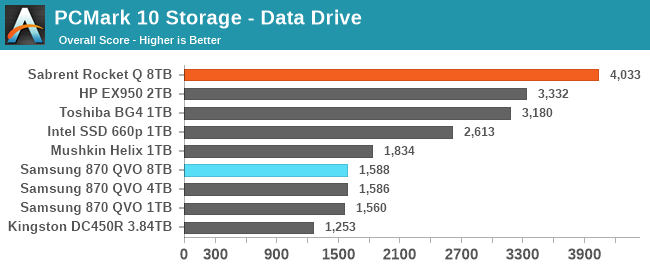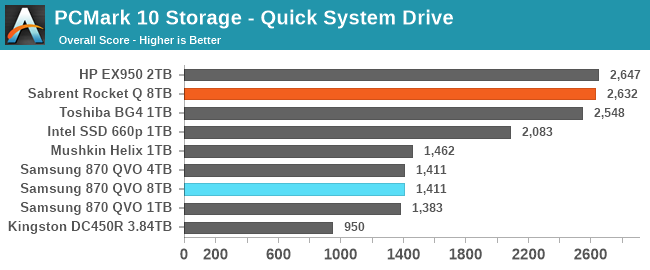QLC Goes To 8TB: Samsung 870 QVO and Sabrent Rocket Q 8TB SSDs Reviewed
by Billy Tallis on December 4, 2020 8:00 AM ESTPCMark 10 Storage Benchmarks
At the end of 2019, UL released a major update to their popular PCMark 10 benchmark suite, adding storage performance tests that had been conspicuously absent for over two years. These new storage benchmarks are similar to our AnandTech Storage Bench (ATSB) tests in that they are composed of traces of real-world IO patterns that are replayed onto the drive under test. We're incorporating these into our new SSD test suite, and including our first batch of results here.
PCMark 10 provides four different storage benchmarks. The Full System Drive, Quick System Drive and Data Drive benchmarks cover similar territory to our ATSB Heavy and Light tests, and all three together take about as long to run as the ATSB Heavy and Light tests combined. The Drive Performance Consistency Test is clearly meant to one-up The Destroyer and also measure the worst-case performance of a drive that is completely full. Due to time constraints, we are not yet attempting to add the Drive Performance Consistency Test to our usual test suite.
| PCMark 10 Storage Tests | ||
| Test Name | Data Written | |
| Data Drive | 15 GB | |
| Quick System Drive | 23 GB | |
| Full System Drive | 204 GB | |
| Drive Performance Consistency | 23 TB + 3x drive capacity | |
The primary subscores for the PCMark 10 Storage benchmarks are average bandwidth and average latency for read and write IOs. These are combined into an overall score by computing the geometric mean of the bandwidth score and the reciprocal of the latency score. PCMark 10 also records more detailed statistics, but we'll dig into those in a later review. These PCMark 10 Storage test runs were conducted on our Coffee Lake testbed:
| AnandTech Coffee Lake SSD Testbed | |
| CPU | Intel Core i7-8700K |
| Motherboard | Gigabyte Aorus H370 Gaming 3 WiFi |
| Chipset | Intel H370 |
| Memory | 2x 8GB Kingston DDR4-2666 |
| Case | In Win C583 |
| Power Supply | Cooler Master G550M |
| OS | Windows 10 64-bit, version 2004 |
Data Drive Benchmark
The Data Drive Benchmark is intended to represent usage a secondary or portable drive may be subject to. This test simulates copying around files, but does not simulate the IO associated with launching and running applications from a drive.
 |
|||||||||
| Overall Score | Average Bandwidth | Average Latency | |||||||
Starting off, the 8TB Sabrent Rocket Q leads the field thanks to its massive and fast SLC cache; it clearly outperforms even the decently high-end 2TB TLC-based HP EX920. The several capacities of the Samsung 870 QVO all performa about the same: less than half the speed of the faster NVMe drives, and slower than the slowest entry-level NVMe drives. The enterprise SATA drive with no SLC caching comes in last place.
Quick System Drive Benchmark
The Quick System Drive Benchmark is a subset of the Full System Drive Benchmark, running only 6 out of the 23 sub-tests from the Full test.
 |
|||||||||
| Overall Score | Average Bandwidth | Average Latency | |||||||
Moving on to the Quick test, the Sabrent Rocket Q no longer stands out ahead of the other NVMe drives, but still offers decent performance. The performance gap between the NVMe drives and the Samsung 870 QVO drives has narrowed slightly, but is still almost a factor of two.
Full System Drive Benchmark
The Full System Drive Benchmark covers a broad range of everyday tasks: booting Windows and starting applications and games, using Office and Adobe applications, and file management. The "Full" in the name does not mean that each drive is filled or that the entire capacity of the drive is tested. Rather, it only indicates that all of the PCMark 10 Storage sub-tests are included in this test.
 |
|||||||||
| Overall Score | Average Bandwidth | Average Latency | |||||||
The Full test starts to bring the downsides of QLC NAND into focus. The Sabrent Rocket Q is now the slowest of the NVMe drives, only moderately faster than the 8TB Samsung 870 QVO. The 1TB 870 QVO is also falling behind the larger and faster models. However, the QLC-based Intel 660p manages to hold on to decent performance, possibly a result of the class-leading SLC cache performance we usually see from Silicon Motion NVMe controllers paired with Intel/Micron flash.










150 Comments
View All Comments
Beaver M. - Saturday, December 5, 2020 - link
Not really. You can get 4TB TLC NVMe drives for around the same price as this QLC one.QLC would need to be 50% cheaper at least to make any sense.
Spunjji - Monday, December 7, 2020 - link
From an actual manufacturing perspective, even 33% cheaper would be a reach. We'll be lucky to see 25%.Beaver M. - Tuesday, December 8, 2020 - link
I agree.Thats why I think they are trying to fool buyers with QLC.
DeathArrow - Saturday, December 5, 2020 - link
Why is Anandtech the last to conduct reviews on many products? By the time you review the latest graphic cards or SSDs, there is not much interest since most people already get their info from other outlets.Beaver M. - Thursday, December 10, 2020 - link
Anandtech has declined massively this year. Most of their "articles" are "Best This And That Buy Right Now" and other ads nowadays.Im about to remove them from my bookmarks...
Luuta - Saturday, December 5, 2020 - link
The product comparisons would be so well and good if companies like ADATA haven't swapped out premium components from initial drive launches for far cheaper ones, with dramatic loss in performance. It's fraudulent. It also makes a nonsense of all these reviews and the comparisons because the consumer won't see any of it, once the first batch is off the production line. These companies need to be held accountable by law to stop them ripping off consumers with their own counterfeit products. Until then, I no longer believe any bench marking of either SSD or hard drive products from any manufacturer.Deicidium369 - Saturday, December 5, 2020 - link
Here's a tip - Stay as far away from the budget manufacturers like ADATA - for our datacenter SSDs it's all Intel Optane U.2 - and for my desktops - Samsung and looking into the new Phison based controllers that are 7GB/s R&W. I pretty much put Sabrent into that category with ADATA - only Sabrent part I have is a 2.5" to 3.5" drive sled.Cliff34 - Saturday, December 5, 2020 - link
For me, the sweet spot is 4 TB. I need a lot of space to store media on my laptop. Right now using 2 TB, I am doing alright. But I feel 4 TB will give me more confidence I won't run out of space.Sadly, it doesn't look like the market is ready to move on. I've got my 2TB three years ago and prices wise, it hasn't changed so much.
Slash3 - Sunday, December 6, 2020 - link
I have two 2TB Crucial MX500s for general storage and they're only ten bucks cheaper than what I paid, over two years ago.MDD1963 - Monday, December 7, 2020 - link
Hmmm...wonder what the "Q" in QVO stands for? :)